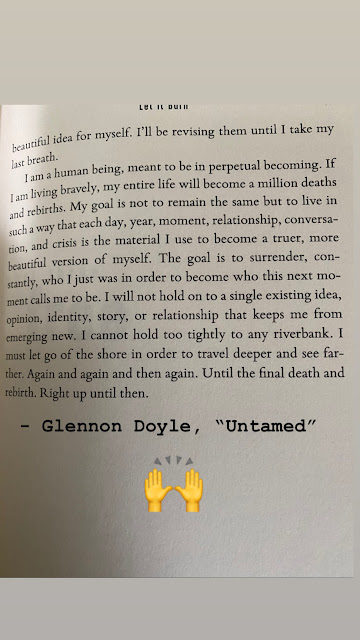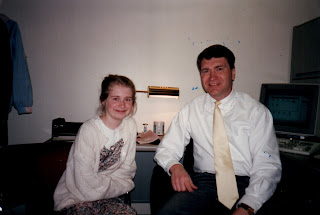(Rupi Kaur, The Sun and Her Flowers)
For the past two years, I've bought my middle son (who's 7 and a lover of all things science and animals) a cup of caterpillars as an early birthday gift. Yes, you read that right -- a cup of caterpillars. They arrive by mail as tiny little creatures in a plastic cup, equipped with all the food they'll need for the first stage of life. While they are safe in their makeshift habitat, we watch them eat, grow, and build their chrysalises. We carefully place the chrysalises in a larger habitat and wait eagerly until one day, they finally emerge as butterflies -- almost as if by magic. And then, when the butterflies' wings are set and they are ready, we take them outside and set them free, watching them fly out into the bright blue sky until they disappear from view.
To be honest, I'm just as fascinated by the process as my kids are. The idea that these little creatures can make such a breathtaking transformation right before our eyes is truly incredible. In their final stage as beautiful, delicate butterflies, it's difficult to even recognize them for the caterpillars they once were -- and yet, we know that some of the components of that caterpillar remain when the butterfly emerges. How can that be? How can something change so profoundly, almost beyond recognition, just like that?
I've been thinking a lot about how the caterpillar's magnificent transformation is symbolic, on some level, of the way that we as humans grow and change over the course of our lives. Back in March, when people first started going into quarantine after Covid hit, a friend shared a meme that really resonated with me:
(Image Source: Facebook, Author Unknown)
I loved the positive spin that it put on a frustrating situation -- the idea that while we couldn't control what was happening all around us, we could control our reaction to it. That we could use this period of slower pace and isolation as a time to reflect and grow. That we could come out of it transformed, changed for the better. It was empowering, to say the least, and it really got me thinking about the changes I'd like to manifest in my own life during that time.
Change and growth are tricky. As humans, we are constantly stuck between two opposing ideas: we strive for change, and yet by nature are resistant to it. Most of us have a version of ourselves that we aspire to be, but have something holding us back -- sometimes we get in our own way for whatever reason, and sometimes it is the weight of other peoples' expectations that keep us glued in place. Sometimes we are reluctant to become the people we really want to be because of some unspoken pressure from those around us (or even from ourselves) to remain just as we are. After all, change is uncomfortable, and difficult, and sometimes messy. By contrast, staying the same feels safe, easy, predictable.
In a recent bout of nostalgia, I was looking through my 12th grade yearbook for the first time in years. I was struck by a common theme to the messages scrawled on the inside pages by many of my classmates. Never change. It was written over and over again -- "You're so sweet. I hope you never change." "You're a cool person. Don't change." It left me wondering why a bunch of 18 year olds had internalized this idea that change was somehow a bad thing.
The sentiment is well-intentioned, of course; it speaks to the idea that sometimes the world can harden us, that the trials and tribulations we'll inevitably face as we make our way out into the world have the potential to dim our light. By "don't change," maybe that's what we really mean -- maybe we're encouraging each other to hold on to those positive attributes within us that are at risk of being dulled by the cruel realities of the world. And that's a valid, noble point -- we should strive to hang on to those things.
But there's a danger in perpetuating the idea that we shouldn't change. We need to change, to grow, to shift, to adapt. It's one of the most important things we can do as human beings -- to continue to transform throughout our lives, constantly striving to be the best and truest versions of ourselves we can possibly be.
Imagine if we actually did take that advice -- "don't change" -- if, as we approached middle age, we were still exactly the same people we were at eighteen. That would mean we hadn't learned from any of our mistakes, that we hadn't taken the time to reflect on what life's challenges had taught us, that we hadn't sought wisdom from the brilliant minds around us and allowed it to shift our own perspectives. It would mean that we hadn't looked inward, asking ourselves how we can better use our gifts and talents to better help those around us. It would mean that we hadn't grown stronger, wiser, more confident and more mature.
(Image Source: success.com)
When I used to teach high school English, we talked about static vs. dynamic characters. Static characters stay the same throughout the novel, while dynamic characters undergo change -- sometimes subtle, sometimes dramatic -- from the beginning of the novel to the end. Typically, the protagonist of the story undergoes the most significant changes, which is expected, as the character arc is a driving feature in literature. The high school English canon especially is full of literary works that would be considered bildungsroman -- coming of age stories. Naturally, the maturation process of the protagonist is an important feature that we discuss as we study these novels. The protagonist begins the novel with [innocence, closed-mindedness, naiveté, fear], but over the course of the novel, transforms into someone with more [wisdom, open-mindedness, maturity, courage]. These themes are common for a reason -- they mirror the experiences that so many of us undergo as we navigate the passage from childhood to adulthood.
As an adult reader, I look for those same dynamic characters in the fiction that I read. I love character-driven novels in which the protagonist undergoes challenges, reflects on what he or she has learned, and uses that newfound knowledge to transform into better version of himself or herself. I look for this in my reading because it rings true to me -- because isn't that what life is all about? Or at least, what it should be about? We live, we learn, we grow, we change. And what is literature if not a way to hold a mirror to the human experience?
I guess it's no surprise, then, that I wanted to play with some of these ideas in my own novel. In Pleasant Bay, I used alternating timelines, jumping back and forth between the summers of 2002 and 2019. There are several characters that appear in both timelines -- namely protagonist Sarah, who in the two timelines is 21 and 38 years old, respectively. Writing the same character in two very different periods of her life was an interesting challenge for me -- I had to reflect a lot on the ways in which I, and the people I know, had grown and changed over that same period in life, from early twenties to late thirties. So many things had happened to Sarah over those years -- motherhood, loss, educational and career advancements, and the inevitable maturity that comes with the passage of time. I needed to think about how these things would have inevitably made her a different person at 38 than she was at 21.
And yet, I also wanted her to retain some of the components of herself that we saw in the earlier timeline. Because that's an important consideration when it comes to growth and change -- there are some things about us that remain the same, always. It's a truth that I discovered while reading my childhood journals, and maybe it goes back to those messages in my high school yearbook -- don't change. Yes, we do change, as we should. But at our cores, there are some aspects of us that do not change. There are some unalterable pieces of us that run so deep, they remain embedded in our personas even as we grow and shift and mature. They are the constants, the non-negotiables. They are the very thread that stitches us together, the purest and truest essence of who we are. They are the pieces of us that our 12th grade classmates beseech us to "never change," and we shouldn't, because they make up who we are at our core.
Interestingly enough, the process of writing this novel (in which personal growth and change is such an important theme) led to growth and change for me on a personal level. That initial period of writing the first draft was my own chrysalis of sorts -- for those first few months of writing, I was so deeply immersed in the process, I didn't get out much or see many people. When I finally did emerge from my "cocoon," ready to take a step back from the manuscript for a little while, I felt like I was not exactly the same person I'd been when I began. It's funny, isn't it? The way you often don't see the changes as they're happening; it's not until after the fact -- sometimes well after the fact -- we look back and realize just how much an experience has transformed us.
I'll end this post with an excerpt from Glennon Doyle, whose hugely successful memoir Untamed gave me a lot to think about regarding the concepts of growth and change.
Glennon Doyle, Untamed






Comments
Post a Comment